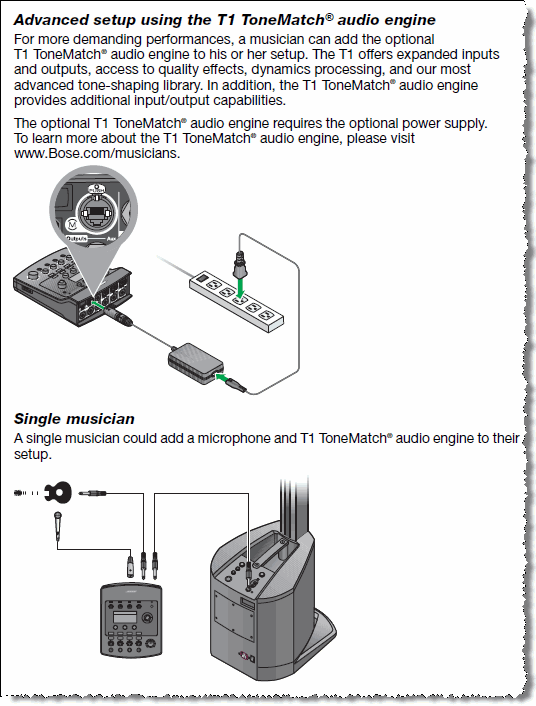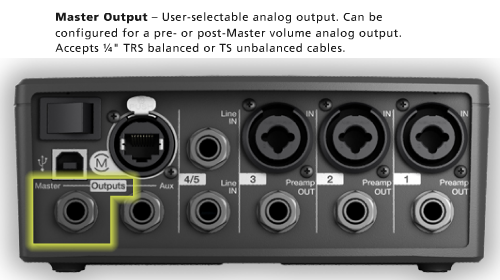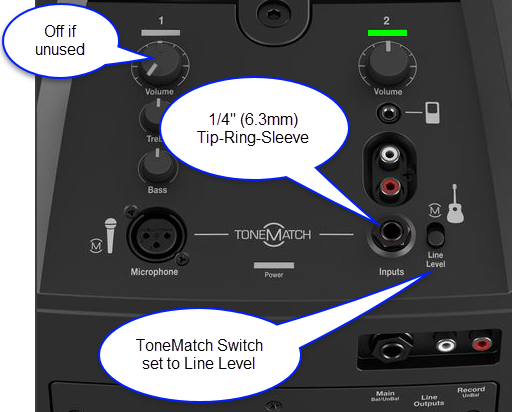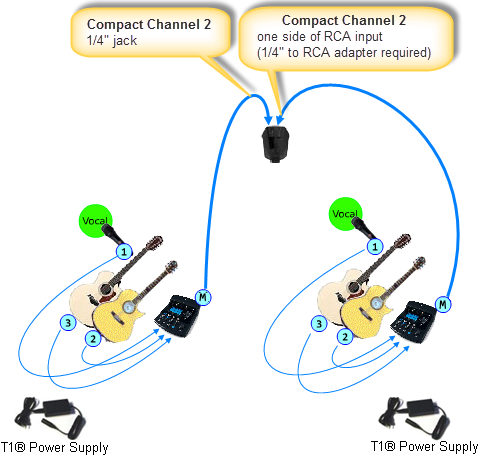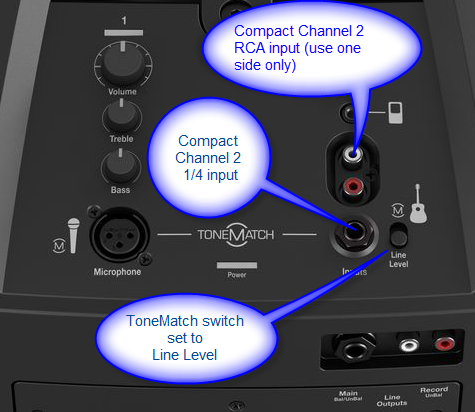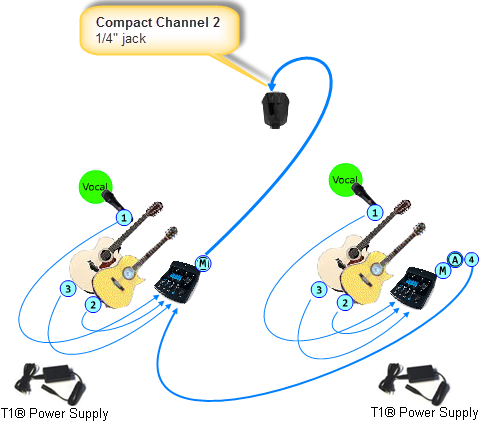Difference between revisions of "L1® Compact"
(Expanded universal power supply) |
m (=== Connections from a T1® ===) |
||
| Line 164: | Line 164: | ||
[http://bose.infopop.cc/eve/forums/a/tpc/f/7521050644/m/745104421?r=294105811#294105811 Source: Cliff-at-Bose] | [http://bose.infopop.cc/eve/forums/a/tpc/f/7521050644/m/745104421?r=294105811#294105811 Source: Cliff-at-Bose] | ||
| + | |||
| + | === Connections from a T1® === | ||
| + | This refers to the connection from a {{T1}} Master or Aux Output using ¼ inch jack connections. | ||
| + | |||
| + | {{#lst:T1 ToneMatch® Audio Engine / 1/4 inch Output Connections to L1® Family Members|Compact}} | ||
| + | |||
=== Zusammenfassung in Deutsch === | === Zusammenfassung in Deutsch === | ||
Revision as of 10:34, 28 April 2009
Interactive Tools
Videos
Documents and Resources
- L1® Compact FAQ (pdf format)
- L1® Compact Technical Data
- L1® Compact Features Functions and Benefits (pdf format)
- L1® Compact Interactive Tour
L1® Products Comparison
FAQs from the Bose® Pro Portable PA Community
Presets
Channel 1:
- T1 ToneMatch® Audio Engine equivalent: Handheld Mics
- L1® Model I equivalent: 01 Handheld Microphones
Channel 2:
- T1 ToneMatch® Audio Engine equivalent: Acoustic Guitar w/piezo
- L1® Model I equivalent: 40 Acoustic Guitar w/piezo
L1® Compact Microphone Accessory Pack
Contents:
- Audix OM3 microphone
- Audix CBL-20 20' XLR cable
- Stereo RCA cable
- 3.5mm Stereo mini cable
The Hand held Mic or Audix OM3 preset both work great.
To obtain pricing and availability please contact 800-444-2673.
Universal Power Supply
The L1 Compact system features a switching power supply that allows it to operate in regions ranging from 100V – 240V. The proper power cord for the specific region in which the system was purchased is included in the product carton.
Available in Bose Retail Stores
The L1 Compact will be offered in all Bose retail stores, the L1 model I and model II will remain in select stores only.
Extensions
The extensions are interchangeable. They contain no speakers.
You can use either or both extensions but we didn't see applications where there are advantages to using one so we don't promote it that way.
- Extended Position
Recommended for larger audiences, the extended position allows users to elevate the L1 Compact loudspeaker array, enabling it to project sound clearly and evenly throughout larger venues. Included with the L1 Compact system are two interlocking L1 Compact extensions used to elevate the array.
- Collapsed Position
Recommended for smaller audiences, the collapsed position allows the L1 Compact loudspeaker array to be inserted in the front of the power stand, creating a very small profile. When used in this position, the system should be placed on top of a table or elevated stage. This will allow sound to project clearly and evenly throughout the room.
For optimal performance we recommend using both extensions when the system is set up in its Extended position.
Drivers
Array Section
There are six high power drivers in the array section.
Vertical Dispersion
- With the Models I and II, I have had to tilt them forward on occasion (no more than an inch on the PS cabinet or back legs) because the output pattern is so horizontal. This made a very audible improvement for the back seats.
I expect, with the Compact, this will no longer be necessary due to the new array configuration. Any idea what the vertical dispersion angle is on the high end? Bose Guy in Calgary
Plus or minus 20 degrees. No tilting needed.
The vertical dispersion is only +-20 degrees which is pretty confined compared to most stand mounted speakers.
The curvature in the array is to achieve the +-20 degree vertical pattern. We designed for that pattern so the speaker would work in a typical raked seating area -- something we thought the L1 Compact system would be used for a lot, and we wanted to make sure that those seated in the front row of a cramped venue with the product in it's extended position would still get sound.
Convex arrangement of 6 speaker array
- I'm curious about the slight 'convex' arrangement of the 6-speaker array. Why that rather than a straight or even a slightly 'concave' arrangement? Source: Dan Cornett
The vertical convexity of the HF array will actually produce a very useful vertical dispersion at HF. The unit needs this. IF it were a straight array, you'd be shooting over the heads of, say, people seated in front of a bandstand looking up. That geometry coupled with the driver articulation (like the L1/II) makes for a spectacular distribution of sound, especially in the HF. It's amazing when you hear it.
Power Stand
The L1 Compact systems power stand has integrated bass with an 8" woofer and will play down to 65hz. The drivers in the loudspeaker array are indeed smaller than those used in the L1 model I and model II systems.
Crossover
We moved the crossover up to 400-ish.
Voicing / T1 ToneMatch® Audio Engine
We voiced all the L1 systems the same, so that tone would be the same on each.
Also, that makes it possible for the T1 audio engine to travel from say a Model II to an L1 Compact system with no additional change of settings on the T1.
Comparisons to Other Members of the L1® Family
These are anecdotes from people-at-Bose.
Ken-at-Bose
What I would say is that the L1 Compact system does not play as loud, nor as deep in bass, nor does it project as far into a room as either the L1 Model I or Model II.
It doesn't really offer expandable bass.
We think its performance and price are very appealing to a large number of people for whom the performance and price of the Model I or Model II are unnecessarily high.
If I played in bigger, noisier rooms, used bass and drums, or played hard driving rock/blues/metal, or had an instrument that really shined because of deep bass etc. I should be steered to the Model I or Model II.
For a quiet, attentive audience I would think that a singer songwriter could comfortably entertain 150 people, give or take, with an L1 Compact system
If the room or people are noisy, take that down to 50.
Cliff-at-Bose
First of all, the L1® Compact is very different in basic nature from the two original ones. It has a head-high vertically-divergent array that is ultra-wide horizontally. the vertical angle is narrow enough so its sound pressure fall-off with distance is not as severe as, say, a guitar amp, but it's somewhat greater than an L1 I or II. We have data galore taken on the L1C array, but to a musician, its not only useless, it's confusing. Thinking about this stuff intellectually leads nowhere.
So, forgetting all this, The L1® Compact sounds the same and, from personal experience playing and singing solo, it feels the same. When I played (this seems to be a typical configuration), the system was off to the side 5' and back of me 4'. It is louder when you get on top of it (unlike the L1) so you need to get a little further from it. But not much.
It's very well behaved and it's easy to arrive at an organically-correct distance from it. But; bottom line; it really behaves like the other L1's. I know it has less overall output than the big ones, but I never felt that limit playing demos for a variety of audiences prior to yesterday's launch. I know the system will allow me to entertain at a level I'm happy with in our live music theater. I really don't want more level from it. Our theater holds over 100 and is acoustically treated to be pretty dry. Charlie Farrin did the same on a number of occasions. He's an experienced pro, playing guitar and singing to demonstrate for other audiences. As an audience member listening to Charlie, I was delighted with the sound quality and level. It was exceptionally articulate musically and I understood all his words, on songs I wasn't familiar with.
I'm guessing if you're playing guitar or keys and singing (a solo gig), you can play for 100 with great quality. I never thought once about the capacity of the LF. My keys are never exaggerated on the low end and I want them to sound like, for instance, a real piano or a Rhodes Suitcase. I'm guessing an organ player playing a heavy bass line and singing, like a solo gig, might put the thing to the test. I haven't experienced this and don't do it myself.
Connections from a T1®
This refers to the connection from a T1 ToneMatch Audio Engine Master or Aux Output using ¼ inch jack connections.
You can connect a T1 ToneMatch Audio Engine to L1 Compact
Here is an excerpt from page 12 of the L1® Compact Owner's Guide (pdf format)
Connect FROM T1 ToneMatch Audio Engine Master or Aux Output using ¼ inch jack connections.
Connect TO the Compact Channel 2 volume straight up (12:00 o'clock to 1:00 o'clock) for good results. You can turn it up higher, but if you see the light on the Compact solid red (flickers of red are okay) or you hear distortion, turn down the volume on the Compact.
Template loop detected: T1 ToneMatch® Audio Engine / 1/4 inch Output Connections to L1® Family Members
Channel 2 Connection from T1 ToneMatch Audio Engine Details
Connect the T1 ToneMatch Audio Engine Master output L1 Compact channel 2.
Turn the Channel 1 volume all the way down (fully counterclockwise) unless you have a microphone attached to it.
Two T1®s to a Single Compact
Two T1®s to Separate Inputs on Compact Channel 2
Compact Channel 2 detail
Suggested by Tom the Guitar Guy[1]
Daisy Chain Two T1®s to Compact Channel 2
Compact Channel 2 detail
- ↑ Tom the Guitar Guy in the Bose L1® Forum
Zusammenfassung in Deutsch
Hier eine kurze (allerdings unvollständige) Zusammenfassung in deutsch:
- Das Abstrahlverhalten i.d. Breite (horizontal) soll aber praktisch identisch mit der L1-Familie sein. Die vertikale Abstrahlung soll bei etwa +/-20° liegen, d.h. man muss die Säule nicht mehr kippen, z.B. um die Zuhörer direkt v.d. Bühne oder auf nach hinten ansteigenden Sitzreihen zu erreichen.
- Reichweite: Die L1® Compact trägt wegen der kürzeren Säule (mit 6 Hochleistungs-Treibern) nicht ganz so weit wie die "grosse" L1, d.h. die Lautstärke fällt mit zunehmender Entfernung etwas mehr ab.
- Leistung: Klar, daß die L1® Compact u.a. aufgrund des deutlich geringeren Gewichtes weniger Leistung als die anderen L1-Modelle hat. Dennoch reicht die Leistung aus, um 150 "ruhige" Zuhörer mit hervorragendem Sound zu versorgen, - bei lauterem Publikum reduziert sich diese Zahl allerdings auf etwa 50 Leute.
Aber natürlich gilt auch hier: Selber hören u. sehen ist besser als viel lesen.
Source: BlackForestMan Wolfgang
Expanded Text from the L1® Compact Page
L1® Compact system
- Bose® Spatial Dispersion™ loudspeaker technology delivers sound evenly across the stage and throughout the audience—even to the extreme sides
- Two ToneMatch® channels with fixed presets for a handheld microphone and an acoustic guitar
- Integrated bass speaker in power stand
- Two setup positions: collapsed for smaller spaces or extended for larger ones
- Ideal for musical performances, mobile DJs, classrooms, business presentations and other events
Introducing the L1 Compact portable line array system. Carry it in one trip. Set it up in one minute. Fill the room with Bose sound.
The new L1 Compact system combines conventional PA and monitors into one sleek unit. Positioned behind or to the side of a performer, DJ or presenter, it delivers wide, even sound coverage throughout the stage area and audience—even off to the extreme sides. It's our smallest, lightest, easiest-to-set-up L1 system, weighing just 29 pounds.
Big sound. Small package
Now you can have quality Bose sound for almost any gig, event or occasion. The L1 Compact system is small enough to fit in your trunk or back seat, and its innovative modular design makes setup easy and fast. You can arrange it in either a collapsed configuration for smaller spaces or a taller, extended configuration for larger ones. No extra gear to haul. No heavy speakers to hoist onto stands. No speaker cables.
A different loudspeaker
The L1 Compact system's slim loudspeaker distributes sound clearly and evenly throughout the room, thanks to Bose Spatial Dispersion technology. The speaker's unusual vertical shape makes it distinctly different from conventional PA speakers―and has a very positive effect on sound coverage. Even audience and band members off to the extreme sides hear the same clear, tonally balanced sound as those in front.
The L1 Compact loudspeaker array is smaller than those in L1 Model I and II systems, but it produces comparable horizontal sound coverage. L1 Model I and Model II loudspeakers project sound further with less dropoff of volume than the L1 Compact array.
Integrated system
With the L1 Compact system, you don't have to carry a separate amplifier, mixer or bass cabinet: They're already built in. The system's power stand includes an integrated bass speaker and amplifier, plus a built-in mixer providing a total of four inputs and two outputs.
Channel 1 is a microphone input with a customized ToneMatch preset for a handheld dynamic microphone. The preset automatically optimizes a handheld microphone's tone when used with the L1 Compact system. Channel 2 accepts up to three inputs at once, including a guitar, keyboard or other instrument, DJ mixer, MP3 player, laptop or projector. It features a customized ToneMatch preset to optimize the sound of an acoustic guitar.
The new L1 Compact system: audio performance, simplified setup and one-trip portability. Only from Bose.


